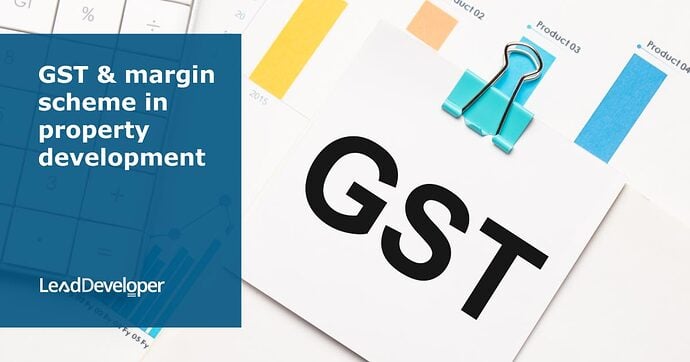GST and Margin Scheme Scenarios
Here is a detailed explanation of GST and the margin scheme, specifically in scenarios involving property development and sales. Here are the key points:
Margin Scheme
It is applicable when you’re buying a property with the intent to develop and sell it. The margin scheme allows GST to be calculated on the sale price minus the land cost, divided by 11, providing a GST formula.
Development & Sales
The margin scheme can apply if a property is developed and sold, assuming no previous development has added value. For the scheme to be eligible, the seller must not have made structural changes.
DA Rejection
The margin scheme can still apply even if a Development Application (DA) is rejected as long as no structural changes have been made to the property. This maintains the property’s eligibility for the margin scheme upon sale.
Buying from Developers
If the price of land from a developer includes GST, the margin scheme does not apply. The buyer can claim GST paid as an input credit, but the margin scheme only applies to properties that haven’t been developed previously.
Overall Savings
Utilising the margin scheme correctly can lead to savings, approximately 3% of the total development cost, which can be significant for larger developments.
Insights based on numbers:
- The formula for calculating GST under the margin scheme is “sale price - land cost / 11,” which simplifies the tax calculation process for developers.
- Despite a DA rejection, the property’s eligibility for the margin scheme remains unaffected as long as no structural development has occurred.
- Correct application of the margin scheme can result in about 3% savings on the total development cost, emphasising its financial benefits for property developers.
Frequently Asked Questions
How does the margin scheme affect the overall cost of property development?
Margin schemes can lead to approximately 3% savings in total development costs. This savings is derived from the scheme allowing GST (Goods and Services Tax) to be calculated on the difference between the sale price and the land cost, divided by 11. This approach can reduce the GST payable on property sales, especially in development projects where the land was acquired with no prior development value added.
In essence, the margin scheme can make property development more financially viable by lowering the tax burden on developers. This advantage is particularly notable in larger developments, where a 3% cost reduction can translate into significant financial savings.
What are the implications of a DA rejection on property development projects under the margin scheme?
A Development Application (DA) rejection does not necessarily negate the application of the margin scheme for property development projects. The margin scheme can still be applied as long as no structural changes have been made to the property. This is true even if a DA has been achieved or rejected. The key factor is whether any value has been added through structural developments; if not, the property remains eligible for the margin scheme.
This information is crucial for developers, as it means that the financial benefits of the margin scheme can still be leveraged despite DA rejections, provided the property hasn’t undergone any physical changes. Thus, the ability to apply the margin scheme and potentially save on GST costs is preserved, highlighting the scheme’s flexibility and value to developers in navigating the complexities of property development and sales.
In what scenarios is a property ineligible for the margin scheme when purchased from a developer?
A property becomes ineligible for the margin scheme when purchased from a developer, and the price includes GST. In such cases, the buyer cannot apply the margin scheme but can claim the GST paid on the purchase as an input credit. This scenario typically occurs when land is bought from a developer, and subdivided the land, and the sales contract specifies that GST is included in the sale price.
In essence, the margin scheme is applicable primarily to properties that have yet to be previously developed or subjected to value addition through development activities.
When a property is bought, including GST, it indicates that it is considered a new or developed product, disqualifying it from the benefits of the margin scheme. Instead, the buyer treats the GST included in the purchase price as part of their cost basis, which can be claimed as an input tax credit, aligning with the standard GST treatment for business expenses.
What is the Margin Scheme?
The Margin Scheme is a tax calculation method used in the property development sector. It allows the Goods and Services Tax (GST) to be calculated on the difference between the sale price of a property and its land cost. This difference, divided by 11, gives the amount of GST to be paid. This scheme is specifically beneficial when buying a property with the intent to develop and sell it.
How is GST calculated under the Margin Scheme?
Under the Margin Scheme, GST is calculated using the formula: (sale price - land cost) / 11. This formula determines the GST amount to be paid on the profit margin of the property sale, rather than the total sale price, potentially lowering the amount of GST payable by the developer.
Can the Margin Scheme apply to any property development?
The Margin Scheme can apply if a property is being developed and sold, provided that no previous development on the property has added value through structural changes. The scheme is designed for properties that are developed and sold without having been previously developed in a manner that adds structural value.
Does a Development Application (DA) rejection affect the Margin Scheme eligibility?
No, a DA rejection does not affect the eligibility for the Margin Scheme. As long as no structural changes have been made to the property, its eligibility for the Margin Scheme remains intact, regardless of whether a development application is approved or rejected.
What happens if I buy land from a developer that includes GST?
If you purchase land from a developer and the price includes GST, the Margin Scheme does not apply to that transaction. However, as a buyer, you can claim the GST paid as an input credit. The Margin Scheme is only applicable to properties that have not undergone previous development that added structural value.
What are the financial benefits of using the Margin Scheme?
Utilizing the Margin Scheme correctly can lead to significant savings, approximately 3% of the total development cost. This saving can be considerable, especially for larger development projects, as it reduces the GST payable on the sale of the developed property by calculating it on the margin rather than the total sale price.
Test Your Knowledge
Multiple-Choice Questions on GST and the Margin Scheme
1. What is the primary purpose of the Margin Scheme in property development?
A. To increase the GST payable on property sales
B. To allow GST to be calculated on the total sale price of the property
C. To calculate GST on the sale price minus the land cost, divided by 11
D. To apply a higher tax rate on property sales
2. Under what condition does the Margin Scheme become applicable for a property?
A. The property has been developed and sold multiple times.
B. Structural changes have been made to the property by the seller.
C. The property is bought for personal use.
D. No previous development has added value through structural changes.
3. How does the rejection of a Development Application (DA) affect the Margin Scheme’s applicability?
A. It disqualifies the property from the Margin Scheme.
B. It has no impact as long as no structural changes have been made.
C. It automatically qualifies the property for a higher GST rate.
D. The property can only be sold without GST.
4. Which scenario renders a property ineligible for the Margin Scheme?
A. Buying a property directly from the government
B. The price of the land bought from a developer includes GST
C. The property has not been previously developed
D. The development application (DA) is pending approval
5. What financial benefit does the Margin Scheme offer property developers?
A. It increases the sale price of the property by approximately 3%.
B. It reduces the GST payable on the sale of the property by about 3% of the total development cost.
C. It eliminates the need to pay GST on property sales.
D. It doubles the savings on GST payable on the property’s sale price.
Answers
- C. To calculate GST on the sale price minus the land cost, divided by 11
- D. No previous development has added value through structural changes.
- B. It has no impact as long as no structural changes have been made.
- B. The price of the land bought from a developer includes GST.
- B. It reduces the GST payable on the sale of the property by about 3% of the total development cost.
Assignment
Practical Exercise on GST and Margin Scheme
Objective
This assignment aims to deepen students’ understanding of the GST and Margin Scheme’s implications in property development and sales. Through a series of questions and practical tasks, students will explore how the Margin Scheme affects the financial aspects of property development, eligibility criteria, and the impacts of Development Application (DA) rejection.
Instructions
Answer the following questions and complete the tasks below. Use the detailed explanation provided about the GST and Margin Scheme as your guide. Ensure your answers are comprehensive and reflect an understanding of the material.
Questions
Calculation Exercise:
Assume you’re developing a property purchased for $500,000 (land cost) and sold for $800,000. Calculate the GST payable under the Margin Scheme.
Scenario Analysis:
Describe a scenario where a property would be ineligible for the Margin Scheme, including the role of GST in the buying price from a developer. How does this affect the buyer’s financials?
DA Rejection Implications:
Explain how a DA rejection impacts the eligibility for the Margin Scheme and the strategic implications for property developers.
To Do
Research Task:
Investigate and report on a real-world example of a property development project where the Margin Scheme was applied. Detail the financial outcomes of using the scheme versus traditional GST calculation methods.
Case Study Analysis:
Create a hypothetical case study of a property development project. Include details such as the purchase price, development costs, sale price, and GST calculations both with and without the Margin Scheme. Discuss the financial viability of the project under both scenarios.
Discussion Prompt:
How does the Margin Scheme encourage or discourage property development, in your opinion? Consider factors such as financial savings, complexity of GST calculations, and eligibility criteria.
Research Questions
Market Impact
How has the Margin Scheme influenced the property development market in your region or country? Consider aspects like market accessibility for new developers, pricing strategies, and overall market growth.
Legislative Context:
Explore the legislative background of the Margin Scheme. Why was it introduced, and what specific issues does it address in the property development sector?
Comparison with Other Countries:
Compare the Margin Scheme or similar schemes in your country with those in another country. How do the objectives, benefits, and challenges differ?
Submission Guidelines:
- Complete all sections of the assignment.
- Support your answers and discussions with examples and evidence where possible.
- Submit your assignment via mail or comments.



